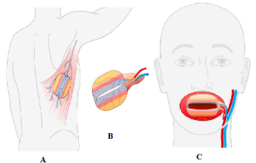Device and method to generate transplantable functional sphincters with muscle, skin, and mucosa
TECHNOLOGY NUMBER: 2021-004

OVERVIEW
An obturator that permits functional lips with muscle, skin, and mucosa- Provides formation of a flap that is both preinnervated and prelaminated
- Mucocutaneous junction implant is placed en bloc in an area of defect
BACKGROUND
Obturators are used to maintain an opening in internal tissues for an extended period of time. An obturator can be used to produce lips, eyelids, and structures of the nose, vagina, and anal sphincter, or it can maintain an opening thru internal tissue layers to provide stabilization. In the case of prelamination, the obturator fortifies tissue layers while maintaining an opening within the prelaminated flap, such as an aperture or stoma. Obturators formation can be customized to a specific need, or they can be manufactured in bulk for common procedures. Some of the most difficult obturators to create are those like lips which include a dynamic composite of mucosa, skin, and innervated skeletal muscles. A significant loss of lip tissue creates both functional and aesthetic concerns, affecting eating, drinking, talking, and social gesturing. A need therefore exists for improved strategies that repair complicated soft tissue defects resulting from trauma, tumor ablation, or congenital deformities.
INNOVATION
Inventors have created an obturator that permits formation of a prelaminated flap to produce preinnervated and prevascularized functional lips with muscle, skin, and mucosa. The prelamination phase involves a reconstructive process whereby a three-dimensional structure is built at a remote site by laminating different layers of tissue components as composite grafts. A coculture of oral and skin keratinocytes is seeded onto one dermal equivalent (DE) containing an intact basement membrane. A barrier is placed on the DE to prevent co-mingling of the two populations, permitting the cells to grow in a bioreactor as a normal stratified epithelium. The mucocutaneous junction implant is then implanted onto the latissimus dorsi muscle to foster development of a microvascular system. This approach allows the structure two weeks to mature before transferring the unit en bloc to the patient’s area of defect, which has been maintained by the obturator. The end result is a prefabricated, prelaminated flap.